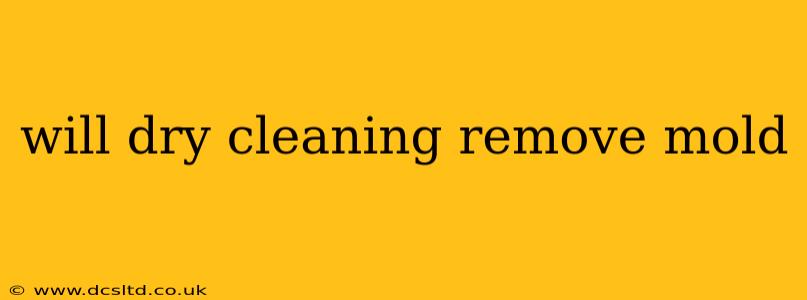Mold infestations are a serious concern, impacting both the structural integrity of your belongings and potentially your health. Many people wonder if a simple trip to the dry cleaner can resolve a mold problem. The short answer is: likely not. While dry cleaning might address some surface mold, it's not a reliable or complete solution for mold remediation. This article will delve deeper into why, exploring the limitations of dry cleaning and outlining more effective methods to tackle mold.
What is Mold and Why is it a Problem?
Mold is a type of fungus that thrives in damp, dark environments. It reproduces through spores, which can spread easily throughout your home. Exposure to mold can trigger allergic reactions, respiratory problems, and other health issues, particularly in vulnerable individuals. Beyond health concerns, mold can also damage fabrics, causing discoloration, weakening fibers, and producing an unpleasant odor.
Can Dry Cleaning Remove Mold?
Dry cleaning uses solvents, not water, to clean clothes. While this might remove some surface mold spores, it's unlikely to penetrate deeply embedded mold or kill the root of the problem. Crucially, dry cleaning won't address the underlying moisture issue that caused the mold growth in the first place. Treating the symptom (the mold) without addressing the cause (moisture) will likely lead to a recurrence.
What Happens if I Try to Dry Clean Moldy Items?
Attempting to dry clean heavily mold-infested items may be ineffective and could even worsen the situation. The solvents used in dry cleaning might not completely eradicate the mold, and the process could potentially spread mold spores within the dry cleaning facility. Furthermore, some dry cleaners may refuse to clean heavily soiled or moldy items due to health and safety concerns.
How to Effectively Remove Mold from Clothes and Other Fabrics
For effective mold removal, a multi-pronged approach is crucial:
- Identify and Address the Moisture Source: The first step is to determine why mold is growing. This may involve fixing leaky pipes, improving ventilation, or addressing condensation problems.
- Proper Cleaning: Depending on the type of fabric and the extent of the mold infestation, cleaning methods vary. For lightly affected items, gentle hand washing with a mild detergent and thorough rinsing might suffice. For more severe cases, professional cleaning services specializing in mold remediation may be necessary.
- Professional Mold Remediation: For extensive mold damage, especially in the case of valuable items or large-scale infestations, consulting a professional mold remediation specialist is essential. They possess the expertise and equipment to safely and effectively remove mold without further damaging your belongings.
- Proper Ventilation and Drying: After cleaning, ensure thorough drying to prevent mold regrowth. This may involve using fans, dehumidifiers, or airing items outside in a sunny, well-ventilated area.
What are the Best Practices for Preventing Mold Growth?
Preventing mold growth is always easier than dealing with an infestation. Here are some key preventative measures:
- Maintain proper ventilation: Ensure adequate air circulation in your home, especially in damp areas like bathrooms and kitchens.
- Address leaks promptly: Repair any leaky pipes or fixtures immediately to prevent water damage.
- Control humidity levels: Use dehumidifiers to keep humidity levels below 50%.
- Regular cleaning: Regularly clean and inspect areas prone to mold growth.
Can dry cleaning remove mold from other items besides clothing?
No, dry cleaning is not effective for removing mold from items other than clothing. The same principles apply: the process won't address the source of the moisture and may not fully eliminate the mold. For other materials like books, furniture, or other household items, professional mold remediation is usually necessary.
Is it safe to handle moldy items myself?
Handling moldy items can be risky, especially for individuals with respiratory sensitivities. If you're unsure about handling a mold infestation, it's always best to consult with a professional mold remediation specialist. They have the necessary safety equipment and expertise to handle the situation safely.
By understanding the limitations of dry cleaning and employing proper prevention and remediation strategies, you can protect your belongings and your health from the damaging effects of mold. Remember, preventing mold is key, but when problems arise, professional help is often the most effective solution.
